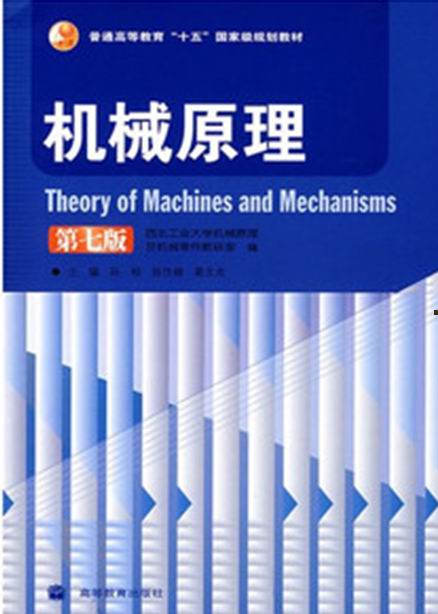《机械原理》双语教学大纲
Bilingual syllabus of " theory of mechanics "
Course name: Mechanisms and machine theory
Course code:141028
Credit:3.5分
Total class hour: 76 class hours
Major in course rightly first: Descriptive geometry、 theory mechanics and Metal technology
Write people: Zhou Chuan Xi
Examine and revise people: Huang Qing Shi
One、Property、the purpose and task of course
The theory of mechanics is basic course of a backbone technology of studying the mechanical generality problem in every speciality of the machinery, it, in the overall situation that mechanical students train, especially in student's initiative spirit and innovation ability, occupy very important position. And machine dynamics basic theories, basic skill that its task makes students know the mechanism studies, the analysis of the daily mechanism of the society and comprehensive method, have preliminary ability to carry on movement conceptual design of the mechanical system.
Two、Basic demand of teaching
Find out about basic conception, at the foundation to understand content of courses, make students know the organization studies basic theories and basic skill with mechanical kinetics, the analysis of the daily omechanism of the society and comprehensive method, have preliminary ability to carry on movement conceptual design of mechanical transmission.
Three、The content of courses and distribute of class hour
Chapter 1 Introduction (two Class hour)
1.1 Study object
1.2 Study content and purpose
Chapter 2 Structural analysis of planar mechanism (eight Class hour)
Key points and difficulty:drawing of kinematic diagram of a mechanism content、calculation of DOF;
2.1 components of planar mechanism
2.2 Kinematic diagram of a mechanism
2.3 Calculation of degree of freedom of a mechanis
Chapter 3 Kinematic analysis of mechanism (four Class hour)
Key points and difficulty:Determining instant centres;The difficulty is the theorem of three centres
3.1 Tasks and methods of kinematic analysis
3.2 The methods of instant centers
Chapter 4 Planar linkage mechanisms (ten Class hour)
Key points and difficulty:Basic concept of planar linkage mechanism; Design of four-bar mechanisms
4.1 Types and application of planar linkage mechanism
4.2 Types of four-bar linkages and variation
4.3 Characteristics analysis four-bar mechanisms
4.4 Design of four-bar mechanism
Chapter 5 Cam mechanisms (eight Class hour)
Key points and difficulty:follow motion curves、Graphical synthesis of plate cam with translating roller follower; Pressure angle of cam mechanisms
5.1 Types and applications of cam mechanisms
5.2 Follower motion curves
5.3 Plate cam with translating roller follower
5.4 Pressure angle
Chapter 6 Gear mechanisms (eighteen Class hour)
Key points and difficulty:Key points are:Fundamental law of gearing properties;Calculation of dimension of standard involute spur gear; The concept of contact ratio;Difficulties are properties of involute;Gearing process of involute gear pairs;Cutting interference;Gearing of helical gear;worm gearing
6.1 Types and applications of gear mechanisms
6.2 Tooth profiles of gears
6.3 The involute and its properties
6.4 Standard involute spur gears
6.5 Gearing of involute spur gears
6.6 Contact ratio of an involute spur gear set
6.7 Manufacturing methods of involute profiles
6.8 Addendum modification on involute gears
6.9 Helical gears for parallel shafts
6.10 Worm gearing
6.11 Bevel gears
Chapter 7 Gear trains (six Class hour)
Key points and difficulty:Key points : The calculation of train ratios of a element epicyclic gear train and a combined gear train;Difficulty is : The method of calculating the train ratio of element epicyclic
7.1 Gear trains and their classification
7.2 Train ratio of gear train with fixed axes
7.3 Train ratio of elementary epicyclic gear train
7.4 Train ratio of a combined gear train
7.5 Application of gear train
Chapter 8 Other mechanism in common use (four Class hour)
Key points and difficulty:Key points are the applications of Ratchet mechanisms and Geneva mechanisms;Difficulty is the motion characteristic of universal joints
8.1 Ratchet mechanisms
8.2 Geneva mechanisms
8.3 Universal joints
8.4 Screw mechanisms
Chapter 10 Balancing of machinery (four Class hour)
Key points and difficulty:Key point is balancing design of rigid rotors;
Difficulty is the calculation of balancing
10.1 Purpose and methods of balancing
10.2 Balancing of dis-like rotors
10.3 Balancing of non-disk rigid rotors
Chapter 11 Motion of mechanical systems and its regulation
(four Class hour)
Key points and difficulty: The equation of motion;Periodic speed fluctuation and its regulation、Calculation of moment of inertia of flywheel angle
11.1 Motion equation of a mechanical system
11.2 Periodic speed fluctuation and its regulation
Chapter 12 Creative Design of Mechanism Systems (two Class hour)
12.1 Introduction to Design of Mechanism Systems
12.2 Kinematic Parameters of the System
Four、Experiment content and distribution of class hour
Experiment one、Visit the showroom of theory of mechanisms and draw the kinematic
diagram (two class hour)
Experiment two、Yardstick comprehensive of linkage and Innovative experiment of
combined mechanisms (two class hour)
Experiment three、Generating Cutting principle of Involute gear and basic size
measurement (two class hour)
Five、The content of computer operate and distribution of class hour
content:The kinematic analysis of planar mechanisms (four Class hour)
Six、The outline explains
The organization analyzes and designs and mainly selects the analytic method for use; In the whole course of teaching, encourage and lead students to combine the practical problem and Conceive the transmission scheme of mechanism, train student's initiative spirit and creativity; Adopt modernized teaching means such as education film, CAI , etc. in concrete teaching, efficiency in order to improve to give lessons and strengthening the teaching result; Course of theory of mechanics is designed and set up alone, time is no less than 1.5 weeks.
Seven、Teaching reference book
1、Charles E.Wilson J.Peter Sadler(秦伟缩编). Kinematics and Dynamics of Machinery.2005.
2、Robert L .Norton(韩建友改编). Design of Machinery (Third Edition).2007.
3、Shigley & Uicker. Theory of Machine and Mechanisms. McGraw-Hill Book Company. 1980.
责任编辑:zhou
